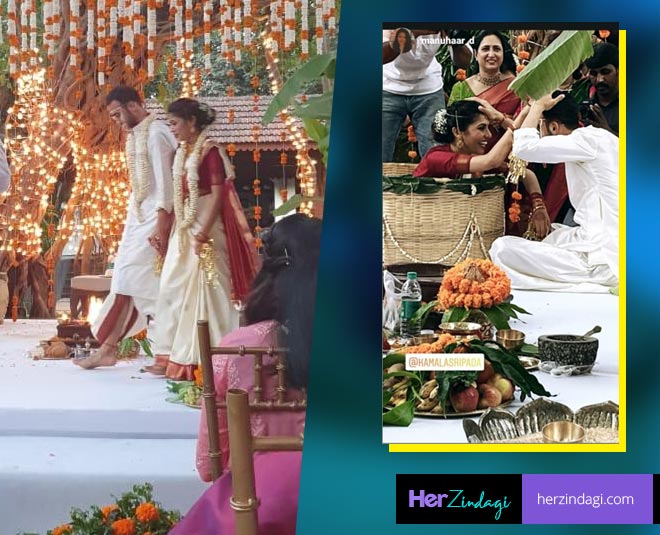
A traditional Hindu wedding has a beautiful ceremony called the pheras. These seven circles walked around the agni or the holy fire, really seal the deal for the couple. Each phera signifies a vow. Traditionally the first four pheras are led by the groom and the last three led by the bride. Just one of the many customs that make Indian weddings complete. And while most couples and their families adhere to these rituals, simply because that's just how it has been done over the years, there are some who are challenging the regressive aspects of these traditions.
The 'modern' Indian weddings are setting new goals. From skipping of the 'kanyadaan' ritual, (because the daughter is not a commodity to give away as 'daan') to couples writing their own vows, Indian weddings are getting more customised & personalized. While giving due respect to culture and religious practices, couples are simply asking why is not time to update?
Yagnik and Kamala decided to do just that. Their wedding was a beautiful celebration of love, respect and equality. #CoupleGoals #WeddingGoals. They have certainly set a benchmark for many.

It all started with Kamala and Yagnik's decision to understand the ceremonies. Both the bride and the groom did not want to go through the rigmarole of the mantras and rituals, without truly understanding what they stood for. Since this was to be a Telugu weds Punjabi celebration, the couple wanted to take the best of both cultures. So that the families also understood the significance of ceremonies, an explainer handout was printed as well.
As per Punjabi traditions, there we four pheras. But instead of the groom taking the lead, and Kamala following him, this couple decided to walk side by side for the pheras. Hand in hand, as equals, together in all of life's ups and downs. How beautiful is that?
HerZindagi caught up with Kamala who graciously agreed to share her thoughts even though she was on her honeymoon! "Both of us tried to understand the meaning of ceremonies we were performing and the vows that we were taking. Our priest and family were flexible enough to let us make all vows for both families, thereby also agreeing that we walk side by side. The last vow in the seven steps or Saptapadi is the vow of friendship or Mitrata. So it was a no-brainer that we'd do this together just like how we'd planned the entire wedding together," she said.

Don't Miss: Behold The Badass Indian Brides: Breaking Traditions, Being Herself

The three-day festivities in a sprawling Goa resort, Kamala & Yagnik's wedding was a celebration of the couple's love and respect for each other. The couple had carefully planned to make it an 'equal' wedding.
Kanyadaan is the archaic ritual of 'giving away the daughter' which is traditionally performed by the men of the family. However, the couple decided to go for a no-kanyadaan ritual. The bride's family completely skipped this ritual.
"We wanted to do ceremonies that were equal in nature. We won some and lost some battles. We didn't do Kanyadaan and didn't do the ceremony where the girl's parents wash the boys feet."
The ceremony was designed to give equal importance to the groom's and bride's cultures. In the spirit of equality, four specific rituals from each side were chosen. The ceremonies began once Kamala and Yagnik both arrived to signify equal importance to both.
Don't Miss: Nusrat Jahan Has Befitting Reply To Those Raising Fingers At Her For Sporting Sindoor & Mangalsutra
Can women not have a conversation around money? That's what we all have been taught for years now! Don't talk about money, don't discuss it and leave it to the men. When it comes to Indian weddings, women are asked to stay out of money decisions, especially the bride. However, that was not the case with this bride. She wasn't asked to sit out of contract negotiations which involved huge amounts of money.
Also, the groom was very much a part of the wedding shopping. Kamala said, "He didn't shy away from shopping for blouse borders." Clearly, we must stop generalising this, men can like shopping too!
'Sindoor dana' is another Indian wedding custom where the groom puts sindoor along the parting of her hair. Sindoor or the red vermilion powder symbolises matrimony. For their wedding, Kamala and Yagnik decided to make all the customs specific to both sides. She shared, "Yagnik offered to get Tika in return for Sindoor so that I'm not the only one with symbols of being married."
In the last few years, there have been women who have punched wedding stereotypes and taboos. Like the woman priest, who stormed the male bastion and solemnised a wedding. Or Jiya, the bride from Alwar who rode a chariot for her baraat, because why should boys have all the fun! And even Kamala, all of these are small steps in bringing about a big change.
Kamala Sripada said, "You may still end up doing a few archaic things- but at least you've opened the conversation for equality so that sets some expectations for everyone. These customs are very old, so even if you don't change all of them- don't beat yourself up about it."
As gender roles are changing and both men and women are yearning for a society of equality and justice, perhaps all that is required is one simple gesture - walking hand in hand, shoulder to shoulder.
What's your take? Would you like to opt for an equal marriage or follow the age-old traditions for the sake of it?
Also watch this video
Herzindagi video
Our aim is to provide accurate, safe and expert verified information through our articles and social media handles. The remedies, advice and tips mentioned here are for general information only. Please consult your expert before trying any kind of health, beauty, life hacks or astrology related tips. For any feedback or complaint, contact us at compliant_gro@jagrannewmedia.com.